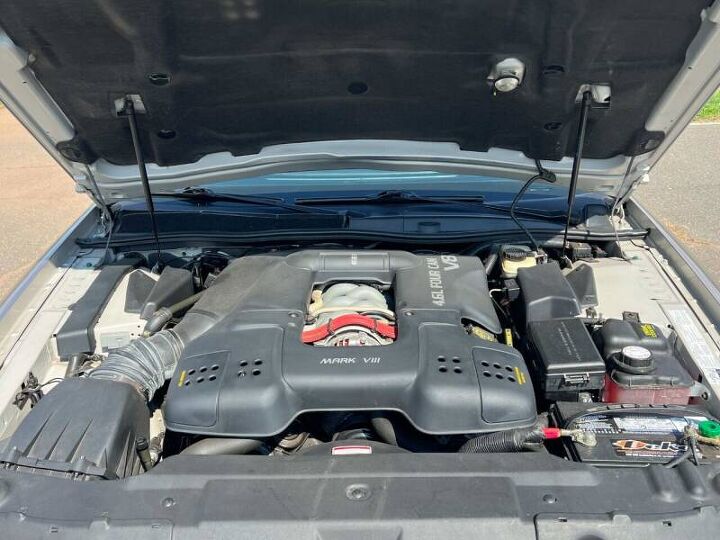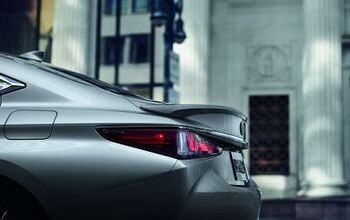Rare Rides Icons: The Lincoln Mark Series Cars, Feeling Continental (Part XLIII)

Ford spent a lot of money and a lot of time on the development of the MN12 platform. An intentional move on the company’s part, the plan was to catch a more elevated customer than those persuaded by the Fox body trio: Ford Thunderbird, Mercury Cougar, and Lincoln Mark VII. In particular, BMW was on the mind of all domestic manufacturers in the Eighties as yuppies pursued status and Ultimate Driving Machine pleasure. Ford attempted to deliver the same experience for less money with its MN12 coupes and derivative FN10; a lightly reworked MN12 chassis used exclusively on the new Mark VIII.
Though it was technically a “separate” platform, the new Mark VIII shared its 113-inch wheelbase with the Thunderbird and Cougar. That was a notable increase over the 108.5-inch measurement of the Mark VII. Other dimensions of the Mark VIII were larger in all directions, a stark contrast to the extreme downsizing implemented on Mark VI, a measure pushed further by the tidy proportions of the Mark VII.
Mark VIII spanned 206.9 inches in length, compared to 202.8” on the outgoing Mark VII. Overall width increased notably, from 70.9” in Mark VII to 74.6 inches on Mark VIII. The more aerodynamic, organic shape of the Mark VIII meant overall height was slightly lower than before at 53.6 inches, over 54.2” for the Mark VII.
Although the Mark VIII was larger than its predecessor, through the use of lighter materials like aluminum it weighed about the same. The Mark VII was 3,748 pounds, and Mark VIII was 3,757 pounds. Worth a quick comparison, the equivalent Thunderbird weighed 3,536 pounds with a V6 engine or 3,725 with the V8. The Cougar was roughly the same depending upon trim level.
One of the most important differences between the Thunderbird, Cougar, and Mark VIII was the latter’s exclusive V8 engine. For the first time ever, a Mark would debut with an engine not offered in other Ford or Lincoln products. Let’s take a quick dive into the world of the Four-Cam V8 that you’d know as InTech.
Part of Ford’s Modular engine family, the new mill shared its 4.6-liter displacement with the company’s standard V8, but was much more technologically advanced. The first four-valve development of the Modular family, the new engine employed dual overhead cams (DOHC). With an aluminum engine block, the V8 used a split port design with two intake ports per cylinder, as well as variable runner length intake manifolds.
All examples of the engine made in 1999 or earlier had blocks cast in Italy, by Teksid S.p.A, a subsidiary of Fiat. Perhaps that bit of detail on the all-American iron was left out of the marketing materials. At the Mark VIII’s debut, the engine was named simply “Four-Cam V8,” but the branding changed to InTech in 1995. The engine was the only one used by the Mark VIII but was exclusive to that model for only 1993 and 1994. By 1995 when InTech naming arrived, the engine spread to the front-drive Lincoln Continental sedan.
The following year InTech made its way into the SVE trim of the Thunderbird and the Mustang SVT Cobra. In 2003 the InTech appeared in its only SUV usage, as the motivator of the new and doomed Lincoln Aviator. Mercury made use of InTech that year, as the engine saw its only Panther platform use in the short-lived Boomer bait Mercury Marauder. The Aviator would be Ford’s last official usage of the InTech engine line when it bowed out in 2005, but the V8 found a home in several other vehicles from smaller manufacturers.
Tiny British firm Marcos used the InTech between 1997 and 1999 as it slowly assembled the Mantis and Mantis GT; the latter version added a supercharger for 506 horsepower. Panoz also used the engine in the AIV roadster between 1997 and 1999, and in the more popular (and ugly) Esperante from 2000 to 2009.
Even more exotic use arrived with the Qvale Mangusta in 2000, the coupe that was originally to herald the return of deTomaso. British maker MG used the engine for three years on the crazy X-Power SV, on sale from 2003 to 2005. Further British usage included the Invicta S1, a badly made sports luxury coupe offered between 2004 and 2012. The S1 was the last vehicle in production anywhere to use an InTech engine.
Perhaps the most exclusive (and powerful) implementation of an InTech was in Koenigsegg’s early vehicles. Proving what performance the engine was capable of, a supercharged version was used in the CC8S of 2003 with an output of 646 horsepower. The company followed up with the CCR of 2004-2006, where another supercharger was added and power jumped to 806 horses and 679 lb-ft of torque.
At its debut in Mark VIII, the Four-Cam engine produced 280 horsepower at 5,500 RPM, and an impressive 280 lb-ft of torque. The powerful engine was attached to the current four-speed version of the AOD automatic used across the Ford company portfolio. With such an advanced engine, premium fuel (91 octane or higher) was recommended for the best performance.
Mark VIII was the first Mark available with dual front airbags, and had four-wheel disc brakes with ABS as standard (optional on Mark VII). The four-wheel independent suspension included a short-long arm design, as well as front and rear stabilizer bars. As in the Mark VII, an electronically controlled air suspension system was standard equipment.
A notable advancement in the Mark VIII’s suspension was programming to lower the ride height slightly at high speeds, which assisted fuel economy via improved aerodynamics. A fairly complex system, it relied on many sensors and solenoids to control the airbags at each corner. For those of you who can read it, enjoy this circuit schematic of the suspension and steering control module.
Lighting was still an important bragging point in the automotive world, and the Mark VIII set some firsts just as the Mark VII had before it. With flush wrap-around headlamps and a rear-lighted heckblende, the Mark became the first domestic vehicle to implement HiD lamps in 1995. When it was facelifted in 1997, the new rear clip sported a much larger heckblende illuminated with neon. Other festive lighting added at that time included puddle lamps and LED signals in the side mirror glass.
New lighting aside, there were many other changes to the Mark VIII’s exterior styling as it debuted in its final and most modern guise. Getting to that finalized styling point was a long, difficult road for Lincoln. Exterior appearances are up next time.
[Images: seller, Ford]
Become a TTAC insider. Get the latest news, features, TTAC takes, and everything else that gets to the truth about cars first by subscribing to our newsletter.

Interested in lots of cars and their various historical contexts. Started writing articles for TTAC in late 2016, when my first posts were QOTDs. From there I started a few new series like Rare Rides, Buy/Drive/Burn, Abandoned History, and most recently Rare Rides Icons. Operating from a home base in Cincinnati, Ohio, a relative auto journalist dead zone. Many of my articles are prompted by something I'll see on social media that sparks my interest and causes me to research. Finding articles and information from the early days of the internet and beyond that covers the little details lost to time: trim packages, color and wheel choices, interior fabrics. Beyond those, I'm fascinated by automotive industry experiments, both failures and successes. Lately I've taken an interest in AI, and generating "what if" type images for car models long dead. Reincarnating a modern Toyota Paseo, Lincoln Mark IX, or Isuzu Trooper through a text prompt is fun. Fun to post them on Twitter too, and watch people overreact. To that end, the social media I use most is Twitter, @CoreyLewis86. I also contribute pieces for Forbes Wheels and Forbes Home.
More by Corey Lewis
Latest Car Reviews
Read moreLatest Product Reviews
Read moreRecent Comments
- Redapple2 All this BEV investment. A bigger impact (less oil consumption) would have been made if we had made PIG UP trucks smaller since 2000 and not HUGEr. (And raised gas tax by $2-3/gallon.)
- ChristianWimmer One of my clients is a company that is actually producing eFuels in Leipzig. Yes, they require a lot of energy to produce but this would not be an issue if Germany had nuclear energy or used the excess energy from wind and solar to produce these fuels. In such a scenario the energy losses wouldn’t really matter.Also, I am told that nations like Spain or the North African nations like Morocco or Tunisia could be ideal places to produce eFuels/Hydrogen due to their abundance of solar power. Again, the energy loses here would not matter since the energy used to produce these fuels is essentially “free”. If this path were pursued, Morocco and Tunisia could become wealthy nations and exporters of eFuels and Hydrogen. Countries with an abundance of solar or wind or hydro energy could be producing eFuels for their domestic consumption and export.Another argument which to me is irrelevant these days ist the poor thermal efficiency of ICE engines (25-35% gasoline, 40-45% diesel). One long trips with cruise control set to 130 km/h and even the occasional venture into the 180-200 km/h zone, my fully loaded (with my gear) A250 (2.0 4-cylinder 224-hp Turbo) can achieve an impressive gas mileage of 6 L / 100 km. That’s phenomenal - I am looking at six 1 liter bottles of water right now and that’s all my car needs to travel 100 km… amazing.So, I am a supporter of eFuels. I love internal combustion engines and if we want to use them in a climate neural way, then eFuels are a must. Also, to me every ICE car is way more sustainable and longer-lasting an an EV. Mazda, Toyota etc. are making the right move IMO.
- Blueice Once you infuse governmental unit regulation & [marketing] and taxpayerfunding, one knows quite well, dat the product or service isdestine to fail; which includes battery vehicles. Just axe yourself how revolutionary have your home batterydevices become ??? I am still waiting. after three decades, for a battery shaver whichonly requires charging two or three times per year.I am glad that I do not have a plug in Frau.
- Tassos Such a heavy breadvan on stilts, with so much HP, AND with ONLY 100 KWH Battery, I doubt if you will ever see 250 miles, let alone 300, under the best of conditions. In the winter, count on 150 miles range.And NO, it looks TERRIBLE. The only SUV that looks great is the RANGE ROVER.
- Tassos They sure are doing the right thing in the SHORT and MEDIUM term.As for the long term, in the long run, YOU'LL ALL BE DEAD, so WHO CARES.








































Comments
Join the conversation
This series is epic, but I now fear you'll never get to the gigantic Falcon/Dart/Nova comparison.
Up next is a comparison of all the cars Tassos and EBFlex have puffed each other's peters in. And you thought this series was long.